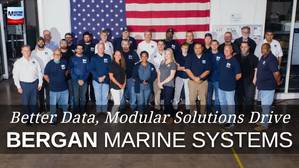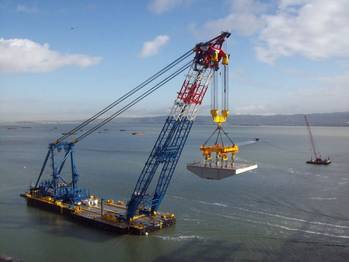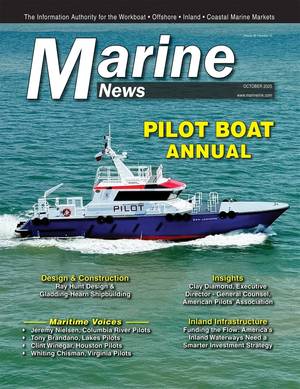Shows of force in Euro military market
For the second time in just two weeks, military- minded visitors made their way to defense industry showcases in Europe and the Middle East, including London's own International Maritime Defence Exhibition (IMDEX), held during the last week in March, following Abu Dhabi's massive IDEX event. Despite the proximity of dates, the U.K. offering at Greenwich still attracted 250 exhibitors, a steady stream of visitors and 12 ships moored up for inspection in West India Docks.
The latter inevitably attracted much attention, largely due to the variety on view. Vessels featured included a SMYGE experimental patrol craft from Sweden, mine countermeasure vessels from France, Germany, Norway, The Netherlands and the U.K., together with the latest Danish Flyvefisken multi-role vessel, a Polish rescue vessel and an Irish offshore patrol ship. The display was completed by a 3,240-ton Nordkapp class coast guard vessel from Norway and — the largest of them all — a 4,330-ton Italian De La Penne class destroyer.
The tone of the four-day event revolved around two major themes: the urgent need for yards to promote and encourage international partnerships and the increasing naval requirements for multi-role vessels.
VSEL, the U K ' s only submarine building company, was upbeat at the show despite the fact that over the next three months it will continue the process of shedding nearly 600 jobs due to cuts in defense spending. This is not new for the company, which has been steadily reducing its workforce since 1990.
Shortly, there will be no more than 5,200 employed at the B a r r o w - i n - F u r n e s s , Cumbria, facility—ayard which used to employ 14,000. Contracts, even for a dwindling workforce are, however, in hand — as VSEL completes the final two vessels in a series of four Trident missile submarines ordered by the Royal Navy, and makes progress with the Batch 2 Trafalgar class project for which it will be tendering later in the year. In its surface shipbuilding capacity, it is constructing the Royal Navy's new helicopter carrier in partnership with Scottish merchant shipbuilder Kvaerner Govan.
Kvaerner will complete the basic ship which will then sail to VSEL's yard to be finished to military specification.
The U.K. Ministry of Defence (MOD) has also confirmed that VSEL is the only bidder for the contract to build the LPD assault ships scheduled to replace HMS Fearless and HMS Intrepid. If the contract is awarded, the ships will be built at Barrow with support again from Kvaerner Govan.
In addition to this link-up on large surface ships, other collaborative ventures are on the go, such as the yard's international sales and marketing agreement with Dutch submarine builder RDM on the Moray class diesel-electric submarine.
Exclusively in the surface shipbuilding category, U.K. company Vosper Thornycroft was talking eagerly of the pending launch of the first of its new series of fast strike craft for the Qatar Emiri Navy. To be named QENSBarzan, the vessel is the first of four in the new Vita class 183.6-ft. (56-m) series and will be supplied together with extensive integrated logistics support including ship documentation, throughlife support and training.
The launch of QENS Barzan will take place less than 14 months after keel laying, an impressive build performance that reflects the modern shipbuilding facilities at VT and has moved Managing Director Martin Jay to comment: "The vessels for Qatar will be among the best VT has built in terms of productivity and quality." (For more on QENS Barzan, turn to page 18.) Despite such obvious success in the Middle East, VT has not been so fortunate in tendering for the remodernization project required by the Brazilian Navy for its six Niteroi class frigates. Although invited as original designer and builder of the vessels to tender as sole prime contractor and project integrator, VT lost out to Italian company Alenia Sistemi Navali. The subsequent contract for $160 million, signed after the Brazilian Senate approved the funding, was won largely because of the company's edge in being able to offer the bulk of the supply packet — e.g. radars, command and control systems, fire-control equipment and a complete missile package.
Italy is also playing its part in the European naval project of the decade, the buzz talk of the show — Project Horizon. Forming the third country with France and the U.K. in another triumvirate military project, the aim to develop a single class of anti-air frigate is now progressing through stage one. Prime contractors for the project are DCN for France, Orizzonte SpA for Italy and GEC-Marconi Naval Systems for the U.K.
French yard DCN International has also, meanwhile, been awarded three other major contracts: to regularly overhaul Saudi Arabian frigates and Underway Replenishment tankers; supply three Agosta 90-B dieselelectric submarines to Pakistan; and build two air-defense frigates for Saudi Arabia. It also continues to work on the i Scorpene family of "next-gen- * eration" nuclear submarines for the French Navy in collaboration with Spanish yard Bazan. At 202.3 ft. (61.7 m) in length with endurance of 50 days, the CM2000's strengths are its platform versatility and state-of-the-art integrated combat system. It has been designed for easy conversion to air-independent propulsion, carries a maximum crew complement of 32 and 18 weapons such as torpedoes and missiles. In Scandinavia, Norwegian yard Kvaerner continues with its program to build the Oksoy/Alta class of minehunters/sweepers. Developed by the navy in Bergen with Defence Research Institute and Det Norske Veritas, the 181.1 x 44.6-ft. (55.2 x 13.6-m) design is of catamaran type with FRP hulls built in sandwich construction.Such a bold choice by the Norwegian Navy was made primarily for higher speed purposes, as the catamaran design is claimed to offer higher transit speeds with less installed power. Other bonuses are lower magnetic and acoustic signatures, clearer water for sonar operations, more comfortable motion and less susceptibility to shock. In total, nine vessels are scheduled to be built in a program lasting until the latter part of the decade. Four, including the first-of-class Oksoy, will be minehunters with the remainder commissioned as sweepers. Each ship will be powered by twin MTU 12V396 TE84 diesels developing 3,700 hp driving two Kvaerner Eureka waterjets, and two MTU 8V 396 TE54 diesels developing 1,740 hp for a speed of 25 knots and range of 1,200 nm at 22 knots. Danyard also brought a firstof-class vessel to the show — a Standard Flex 300 — built for the Royal Danish Navy (RDN) as the lead ship of a total of 14 units, of which all but two have been delivered. Replacements for the Daphne and Soloven classes, Flex 300s are multi-role in concept, able to perform duties as a surface combat unit, ASW unit, MCM/minehunter, minelayer and even as a pollution combat and hydrographic survey vessel in non-military mode.
The vessels are designed for operation primarily in the Danish Straits, their approaches, and the Baltic Sea. In peacetime the SF300 serves as the surveillance and policing workhorse of the RDN, is staffed by a skeleton crew and equipped for search and rescue operations.
Other work in hand is on a series of 10 SAV class minehunter drones, 195.8-ft. (59.7-m) long vessels each powered by a Schottel pump jet.
With trials completed last year, full production has now commenced. The vessels are designed to be operated in pairs by the SF300s and have hulls based on the Hugin class TRVs with low noise propulsion. Configured to tow a side-scan sonar, each vessel can either be remotely controlled or maneuvered from the wheelhouse.






